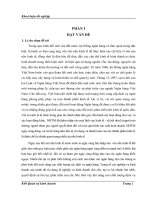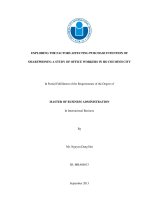Khóa luận tốt nghiệp factors affecting purchase intention in the paid music streaming services in ho chi minh city
Bạn đang xem bản rút gọn của tài liệu. Xem và tải ngay bản đầy đủ của tài liệu tại đây (1.36 MB, 67 trang )
TABLE OF CONTENTS
CHAPTER 1. INTRODUCTION ....................................................................................... 1
1.1.
Background of the study ............................................................................1
1.2.
Research Objectives and Research Questions .........................................4
1.1.
1.1.1.
Research Subjects and The Scope of Research ..................................................... 4
Research Subjects ................................................................................................ 4
1.3.
Research Methodology ...............................................................................5
1.4.
The practical significance of the thesis .....................................................5
1.5.
Thesis structure ..........................................................................................6
CHAPTER 2. LITERATURE REVIEW ........................................................................... 8
2.1.
Previous Empirical Studies .......................................................................8
2.2.
Theoretical Background and Hypothesis Development .......................14
CHAPTER 3. METHODOLOGY .................................................................................... 30
3.1. Research Process ..........................................................................................30
3.2. Survey Design................................................................................................32
3.3.
Data Analysis Methods ............................................................................35
CHAPTER 4. RESEARCH RESULTS AND DISCUSSION ........................................ 39
CHAPTER 5. CONCLUSION .......................................................................................... 46
5.1.
Conclusion .................................................................................................46
5.2.
Implication ................................................................................................47
5.3.
RESEARCH LIMITATIONS .................................................................48
5.4.
FURTHER RESEARCH DIRECTIONS ...............................................48
REFERENCES................................................................................................................... 50
APPENDIX ......................................................................................................................... 53
LIST OF FIGURES
Figure 1 - Proposed Conceptual Model by Vafa Saboori-Deilami and Chang Seob
Yeo (2019)...................................................................................................................9
Figure 2 - Conceptual Model by J Y Chai, L K K Ken, K H Chan, S X Wan1 and T
T Ting (2021) ............................................................................................................11
Figure 3 - Conceptual Model by Mariana Lopes Barata and Pedro Simoes Coelho
(2021) ........................................................................................................................12
Figure 4 - Conceptual Model of Thomas M. Wagner and Thomas Hess (2013).....14
Figure 5 - Conceptual Model ....................................................................................21
Figure 6 - Research process ......................................................................................30
Figure 7 - Hypothesis Testing ...................................................................................44
SYMBOLS AND ABBREVIATIONS TABLE
Number
Symbols
Detail name
1
IFPI
International Federation of
Phonographic Recordings
2
TPB
Theory Planned Behavior
3
MSS
Music Streaming Services
CHAPTER 1. INTRODUCTION
1.1.
Background of the study
According to a Q&Me report that conducted a survey based on 1500 people including
18 to 44 years old nationwide in 2021, music is the most favorite entertainment
medium of Vietnamese people with more than 70% of people listening to the survey
music for more than 30 minutes a day. Currently, the popular music listening
applications of Vietnamese people are mostly non-paid applications such as Youtube
Music, Zing Mp3, NhacCuaTui, etc. This is not difficult to understand when Vietnam
is a country that has not had any copyright protection laws for products ranging from
music to movies. But in recent years, the emergence of international music applications
such as Spotify, Apple Music, Itunes, ... has changed the landscape for the Vietnamese
music market.
Streaming is popular in developed music industries. In 2022, streaming grew by 65%
of the total revenue of the global music industry - a marked increase on the prior year‘s
growth rate (+24.3%), and had over 532 millions user of paid subscription accounts,
according to a report released by the International Federation of Phonographic
Recordings (IFPI). The development of streaming contributes to building a civilized
music environment because it is closely tied to the interests of artists, music listeners
and product copyrights. In Vietnam, streaming is at an early stage with great potential:
39,6% of people listen to music streaming services, the average music streaming time
per day is about 1 hour and 11 minutes (Updated January 2022 of We Are Social).
Revenue in the Music Streaming segment is projected to reach US$26.70m in 2022 and
expected to show an annual growth rate (CAGR 2022-2027) of 6.66%, resulting in a
projected market volume of US$36.85m by 2027. The race to win the hearts of
listeners is not only in the criteria of copyright or monopoly business but also in
technical and technological factors to optimize the user's listening experience.
1
Researches on Music Streaming Services have attracted special attention from
domestic and foreign researchers. Studies have shown a lot of different factors
affecting the intention to buy as well as use paid music services. D rr et al. 2010
examined different service features‘ influence on people‘s willingness to pay for MaaS
services by surveying 132 MaaS users. D rr 2012 applied the Theory of Planned
Behavior TPB to look behind music pirates‘ intentions to use MaaS and to pay for
such services. A total of 132 music pirates would use the basic, free version but had
very little intention to pay for the premium version. Users‘ subjective norms and
attitudes towards the service proved to have the most predictive power when
explaining people‘s intention to use MaaS. MaaS‘s relative advantage over illegal
downloading influenced users‘ attitudes towards the service. Wagner, Benlian, and
Hess (2013) used the Dual Mediation Hypothesis to investigate whether free versions
occur as advertisements for premium versions within freemium business models. Their
results indicate that there is no advertising effect between free and premium versions.
No other studies have explained users‘ willingness to pay for a service that is also
available for free. Aapeli (2016) applied the UTAUT2 model to suggests that paid
MaaS services should focus on providing their users a good price value and hedonic
pleasure, while exploiting consumers‘ tendency for habitual system usage. Also used
the model UTAUT2, Mariana and Pedro (2021) confirm that habit, performance
expectancy and price value play the most important role in influ- encing the intention
to use a paid music streaming service. Simultaneously, new dimensions such as personalisation, attitude towards piracy and perceived freemium-premium fit arise as having
an additional relevant role in adopting this type of service.
In this thesis, the author choses the Theory of Planned Behavior (TPB) as the
theoretical framework for the conceptual model. The TPB belongs to the most
powerful predictive persuasion theories and has been used several times in the
Information Systems field to measure user acceptance and adoption. One advantage of
2
the TPB is its flexibility in allowing new variables (Ajzen, 1991). In past studies
regarding the acceptance of music distribution channels, the TPB was used and
extended successfully e.g., d‘Astous, Colbert and Montpetit, 2005; Plowman and
Goode, 2009). According to Ajzen (1991) the actual behavior is guided by three factors:
evaluations of the behavioral outcomes (attitude), beliefs about the normative
expectations of others (subjective norm), and beliefs about the factors that could
strengthen or weaken the performance of the behavior (perceived behavioral control).
This study inherits and develops the TPB theory with age, gender, and occupation
being the moderating effects on the intention to use paid Music Streaming Services
(MSS) of individual customer in Ho Chi Minh City. The use of this theory to study the
influence of factors on the adoption of MSS has been studied in other countries, but the
context of different countries, different levels of economic development, cultures have
shown that the research results are different, so the previous research results are not
suitable for the context of Vietnam and especially Ho Chi Minh City. In the face of the
rapid development of the music industry, the development of music applications has
been focused by companies in the industry. However, the percentage of people paying
fees to use the service is still modest. Specific studies in the context of Vietnam from
the perspective of customers are pretty rare.
On that basis, studying the factors affecting purchase decisions of customers in paid
music streaming services in Ho Chi Minh City is very important. The findings from
this study can help companies come up with solutions tailored to specific customer
segments. Stemming from the above reasons, the author will use the TPB model with
adjustments and supplements to suit the Vietnamese situation to answer the research
questions which factors affect to the decisions to purchase services of customers,
application usage behavior in Ho Chi Minh, the degree of influence of each factor on
the decision to pay fees or not in the thesis with the topic: Factors Affecting The
3
Customer’s Purchase Intention In The Paid Music Streaming Services In Ho Chi
Minh City.
1.2.
Research Objectives and Research Questions
1.2.1. Research Objectives
The study suggests several approaches to innovate and increase quality in order to
develop a business growth plan.
Identify the factors of paid music streaming services affect on the customer‘s
purchase intention in the paid music streaming services in Ho Chi Minh City.
Determine the level impact of each factor on consumer purchase decisions.
1.2.2. Research questions
This research is aimed to probe the factors of paid music streaming services which
have significant impact on customers‘ intentions to purchase services in Ho Chi Minh
City. The research questions are:
Which factors of paid music streaming services affect to the intentions to
purchase services of customers in Ho Chi Minh City?
To what extent each factor affect customers‘ intentions to purchase services?
1.3.
Research Subjects and The Scope of Research
1.3.1. Research Subjects
A study of investigating of factors of paid music streaming services which have
significant impact on customers‘ intentions to purchase services in Ho Chi Minh
City.
1.3.2. The Scope of Research
In term of space: customers in Ho Chi Minh City.
In term of time: from August to November, 2022
4
1.4.
Research Methodology
This study was carried out using a combination of qualitative and quantitative research
methods.
-
Qualitative research method: Conducted in the period of reviewing and
summarizing previously published works at home and abroad in order to clarify
research concepts and build questionnaires. Next, individual in-depth interview
techniques are used to explore and build observed variables used in measuring
research concepts and building theoretical models for research. The collection
of information is done through the form of a survey of the subjects, based on
the outline outlined in advance.
-
Quantitative research method: It is carried out based on the application of
techniques such as Crobach's Alpha reliability test, exploratory factor analysis
EFA, and structural modeling linear SEM. Information was collected by
questionnaire to survey the opinions of consumers in Ho Chi Minh City. Ho Chi
Minh. The estimated sample size is 300. Quantitative research results are used
to verify the discovery results from qualitative research, thereby, evaluate and
conclude about the research problem..
1.5.
The practical significance of the thesis
The combination of factors in the theoretical model of Theory of planned behavior
(Ajzen, 1985, 1991) and the theory of Perceived Value, Perceived Risk to synthesize
new observed variables that have never been considered in the previous study. previous
studies in Vietnam on factors affecting the decision to buy paid online music services.
The topic contributes to determining the factors affecting customers' intention to buy
online music services, specifically studying the impact of customer psychological
aspects, risks in using the product. The topic applies research results for businesses to
have a suitable orientation in the process of promoting customers to pay for online
music services.
5
1.6.
Thesis structure
In addition to the introduction, conclusion, list of references, the thesis content is
structured into 5 chapters:
Chapter 1: Research Overview
Chapter 2: Literature Review
Chapter 3: Research Methodology
Chapter 4: Results
Chapter 5: Conclusion and suggesting solutions
6
CHAPTER 1 SUMMARY
In chapter 1, the author presented the content of the research issues, including the
reasons for choosing the topic, the research objectives and scope, the research methods
and the overall layout of the research topic. This is the basis for the next chapters in
this study.
7
CHAPTER 2. LITERATURE REVIEW
Chapter 1 gave an overview of the study. In chapter 2, this chapter will present the
theoretical basis of the researches related to the factors affecting the customer's
decision to buy paid online music services. From there, the author presents a research
model and research hypotheses about the impact of the factors affecting the purchase
decision of paid music services of customers.
2.1.
Previous Empirical Studies
2.1.1. The model of Vafa Saboori-Deilami and Chang Seob Yeo (2019)
In ―Paid Music Streaming: What Drives Customers‘ Choice?‖ by Vafa SabooriDeilami and Chang Seob Yeo, 2019) investigates factors that determine the
choice of consumers in selecting online music streaming services, and factors that
affect the customer‘s choice to opt for a paid music streaming service. This paper
explains that customer‘s choice is affected by several perceived elements which
could be categorized as subjective and objective. Subjective factors mainly deal
with the psyche of the customer, whereas objective factors are concerned with
characteristics of the streaming service. Results of this study show that perceived
value acts as a mediator between quality of service and likelihood to subscribe.
One major implication of this finding for practitioners is that although highest
quality might be very appealing to customers, quality would always be factored in
the value of the service. Therefore maintaining a balance between quality and
value is crucial to convince customers to subscribe to a music streaming service.
However, this research has some limitations, among which one can refer to only
investigating the top three music streaming services. Although Apple Music,
Spotify, and Pandora control more than half of the paid music streaming market,
the results of this study would be by far more conclusive if all paid music
streaming service were examined. Another shortcoming of this research is use of
primary data as the only source for analysis. Although the sample size was large
8
enough for a study of this type, the results would possess higher validity if
multiple methods of data collection were used in this study. As a suggestion for
future research, authors suggest using secondary information or qualitative data in
conjunction with primary data to corroborate the results.
Figure 1 - Proposed Conceptual Model by Vafa Saboori-Deilami and Chang Seob Yeo (2019)
2.1.2. The model of Chai et al (2022)
In ―Digital Music: A Study Of Factors In Influencing Online Music Streaming
Service Purchase Intention‖ by J Y Chai, L K K Ken, K H Chan, S X Wan1 and
T T Ting, 2022) identifies the factors that will affect the willingness of the
consumers to subscribe to online music streaming service (Purchase Intention).
Online questionnaire is conducted and the result is analysed by Pearson
Correlation and Cohen‘s f2, effect size. To test the hypotheses, data are collected
by distributing the online questionnaire prepared in Google Form (adopted from
Barros‘ research 2017 .This study has accumulated data from a total 200
respondents who are all Malaysian. The findings show that Perceived Value,
Tangibility Preference, Music Affinity and Music Piracy Awareness are the
9
factors that will significantly influence the consumers‘ Purchase Intention in
online music streaming service.
This research has some limitations. First and foremost, the research method that is
used in this research is an online questionnaire. The benefit of the online
questionnaire is that it could significantly reduce the time needed to collect data.
As a downside, this method of data collection may only limit the questionnaire
recipient to only Internet users and since most of the Internet users are students,
their responses are confined into a single pattern which might causes biased
results. Therefore, the findings of this study might not represent the entire
population. The findings of this study can be further validated by including
respondents of different age groups and ethnic to provide an even broader view of
the study.
During this research, the main focus is the consumer Purchase Intention on
Online Music Streaming Service (OMSS). However, the platform that is chosen
to be used for the OMSS is not studied. Therefore, it would be better if further
research can include the research on which platform is chosen by each respondent
so that the weaknesses and strengths of each of the platforms is able to provide a
clearer image on the Purchase Intention. Besides, this study does also not include
every factor that might affect consumers‘ purchase intention and only measures
the declared intention. This is because it would be impracticable to include a large
number of factors in one survey due to its increased complexity. Therefore, a
different set of factors for predicting consumers‘ Purchase Intention should be
considered in the further research such as sense of fashion, economic status, age
and gender. On the other hand, interesting research topics can be studied in the
future such as research on the effect of advertising on the consumers‘ decision
and also factors of in-app purchases.
10
Figure 2 - Conceptual Model by J Y Chai, L K K Ken, K H Chan, S X Wan1 and T T Ting
(2021)
2.1.3. The model of Mariana and Pedro (2021)
Also in ―Music streaming services: understanding the drivers of customer
purchase and intention to recommend‖ by Mariana Lopes Barata and Pedro
Simoes Coelho, 2021) examines the factors that influence music consumption
through streaming platforms, particularly studying the intention to adopt premium
(paid) versions of a music streaming service and recommend them. An extension
of the UTAUT2 model (version of the Unified Theory of Acceptance and Use of
Technology, applied to the consumer side) was created. Based on data collected
from 324 music streaming services users, the framework of this study was tested
using structural equation modelling (SEM). Research also included indepth semistructured interviews in order to generate a more profound knowledge about the
profile, behaviours and motivations of the new music consumer. The findings
confirm that habit, performance expectancy and price value play the most
important role in influencing the intention to use a paid music streaming service.
Simultaneously, new dimensions such as person- alisation, attitude towards
piracy and perceived freemium-premium fit arise as having an additional relevant
role in adopting this type of service. The research contributes insights into music
streaming services consumer behaviour, providing several theoretical and
practical implications to music streaming services providers.
11
Figure 3 - Conceptual Model by Mariana Lopes Barata and Pedro Simoes Coelho (2021)
2.1.4. The model of Thomas M. Wagner and Thomas Hess (2013)
In ―What Drives Users to Pay for Freemium Services? Examining People‘s
Willingness to Pay for Music Services‖ by (Thomas M. Wagner and Thomas
Hess, 2013) developed a research model to identify antecedents of consumers‘
intentions and attitudes towards the premium version of music services when a
free version is available based on the Theory of Planned Behavior. The results of
our survey with 157 participants show that using the free version has a negative
impact on users‘ intention to pay for the premium version. This study is the first
to investigate users‘ intention to pay for a premium service in the presence of a
free basic service. On a theoretical level, we have once more demonstrated the
12
TPB‘s applicability to new research contexts. Overall, we were able to explain
49.6% of the variance in people‘s intentions to use premium MaaS.
The intention to use the free service showed the strongest negative influence on
the intention to use the premium service. People seem to be satisfied with the free
version and therefore see no need to pay for the service. MaaS providers should
make the full premium service available to users for a free trial period so that they
become accustomed to the use of MaaS. After a certain amount of time, the trial
period will end and users will be forced to pay for further access to the service.
This would be a time-limited freemium and contradict the hitherto-practiced
feature-limited freemium, which promotes both the free and premium products. In
addition to intentions, attitude has the strongest impact on users‘ willingness to
pay for premium products, followed by subjective norm. Users are influenced by
the choices of their families, friends, etc. MaaS providers should use marketing
techniques, like sponsored links on Facebook, to show potential users that their
friends are using MaaS too. Spotify, for example, has allowed its users to share
playlists via social media from the start and forces them to connect their Spotify
accounts with Facebook.
However, this study has some limitations. The sample consists of students and is
not representative of the MaaS services user base. The general model was tested
using MaaS as an example, which is why it is not possible to generalize the
results to all freemium services. Other industries in the internet business also use
freemium models. However, they use different techniques to force users to pay
for premium products (e.g., better quality of articles in newspapers, or time
advantages in games). Our model did not include such specific attributes;
however, as long as its applicability was not tested in other industries, a
generalization is not possible. Our results indicate that separating free and
premium products can increase people‘s intention to use the premium version.
13
However, lock-in effects resulting from the free version may also have a positive
effect on users‘ willingness to pay. Future studies should therefore focus on habit
and the resulting lock-in effect in detail.
Figure 4 - Conceptual Model of Thomas M. Wagner and Thomas Hess (2013)
2.2.
Theoretical Background and Hypothesis Development
2.2.1. Theoretical Background
2.2.1.1.
The Theory of Planned Behavior
Theory of planned behavior (Ajzen, 1985, 1991) states that human behavior is a
product of behavioral intentions. This theory posits that these intentions in turn are
driven by human attitude towards the specific behavior. Theory of planned
behavior also states that two other factors, subjective norm, and behavioral control,
also influence the behavioral intention. Ajzen (1991, p.188) defines the attitude
towards the behavior as ―the degree to which a person has a favorable or
unfavorable evaluation or appraisal of the behavior in question‖. Attitude is formed
through the evaluation of individual‘s beliefs about the outcomes of the behavior
and the assessment of the appropriateness of those outcomes. In other words, the
individual‘s attitude toward certain behavior could be measured as the product of
14
perceived consequences for the individual and the level of desirability for those
consequences.
According to Ajzen (1991, p.188), subjective norm surrounding the performance of
the behavior are ―the perceived social pressure to perform or not to perform the
behavior‖. In other words, subjective norm is reflective of the individual‘s mindset
towards whether people who are significant to him or her, believe that this specific
behavior should or should not be performed. The more an individual is willing to
comply with the opinion of the important referent, the higher the weight of their
opinion. Therefore, total subjective norm is the product of individual‘s perception
towards referent‘s judgment and the willingness of the individual to comply with
referents‘ perceived belief.
Perceived behavioral control is the most pivotal concept in the theory of planned
behavior. According to Ajzen (1991) this is what makes the theory of planned
behavior different from the theory of reasoned action (Fishbein and Ajzen, 1980).
In the theory of reasoned action Fishbein and Ajzen (1980) argued that intentions
are only driven by subjective norm and attitudes towards behavior. Ajzen (1991,
p.183) defines perceived behavioral control as ―people‘s perception of the ease or
difficulty of performing the behavior of interest.‖
According to this theory, people perceive that they have different levels of control
over their behaviors. These perceived controls vary on a range from behaviors that
easily could be performed to behaviors that demand significant amounts of efforts
and assets. Ajzen argues that in fact, there is an association between the actual
behavioral control and behavior. However since measuring actual control incurs
considerable difficulties, perceived behavioral control should be used as a proxy
for assessing the actual control.
2.2.1.2.
UTAUT – UTAUT2
15
Technology acceptance model (Davis, 1989) is one of the most widely used and
empirically tested theoretical models for explaining the user behavior in different
computer systems applications (Davis et al., 1989; Mathieson 1991; Szajna 1996;
Hu et al., 1999; Koufaris, 2002). According to the technology acceptance model,
users‘ attitudes towards the computer system affect their intention to use the
system which in turn leads to the actual use of the computer system (Davis, 1989).
Technology acceptance model proposes that when users are faced with a new
technology, two factors influence their attitude and consequently their decision
about the usage of the new technology.
According to Davis (1989) these two factors are ―perceived ease of use‖ and
―perceived usefulness‖ of the new technology. Davis (1989, p.320) defines
perceived ease of use as ―the degree to which a person believes that using a
particular system would be free from effort‖ and the perceived usefulness as ―the
degree to which a person believes that using a particular system would enhance his
or her job performance‖.
Technology acceptance model has been repeatedly revised by scholars (Venkatesh
and Davis, 2000; Venkatesh and Bala, 2008; Venkatesh at al., 2003). Venkatesh
and Davis (2000) explained the reasons for users‘ perceived usefulness and ease of
use in more details. Specifically they broke down the reasons to three time frames
of before implementation, after implementation, and long after implementation.
They argued that main foundations for creating perceptions towards usefulness of a
computer system are the users‘ mental judgment of the alignment between
essential objectives at work and the results of conducting the task related to one‘s
job using the computer system. Results of their study showed that their findings are
valid in voluntary and compulsory work environments.
Since customers of online music streaming services are in effect computer users,
therefore, their behaviors, decisions, and reactions towards this new disruptive
16
technology could be well explained by a behavioral information system theory like
technology acceptance model.
2.2.1.3.
Perceived value theory
Perceived value is the overall utility value of a product or service that a consumer
perceives based on a cost-benefit trade-off (Zeithmal 1988). Success and the
adoption of a technology or service is based on specific values that a consumer
perceives or desires from a service. These values can be related to functional,
product, or technical aspects of a technology or service. Several studies aimed to
measure these values from a consumer‘s perspective Praveena & Thomas, 2014;
Pal & Triyason, 2017). However, determining the impact of specific values derived
from the use of technologies, streaming services, etc., will be more beneficial from
a consumer‘s viewpoint. Perceived value as a concept is discussed in a number of
previous studies in relation to information systems (Singh et al., 2020), mobile
services (Singh et al., 2017), streaming services (Shin et al., 2015), brand
behaviour (Peng et al., 2014), etc. These studies discussed either perceived value as
a whole, for example, the unidimensional price-based value theory (Marchand &
Hennig-Thurau, 2013) or multidimensional perceived value theory based on effects,
namely consumption value theory, means-end theory, etc. (Sheth et al., 1991).
Originally, five broad aspects of perceived value (social, emotional, conditional,
epistemic and functional) were included by Sheth et al. (1991) in their study. In
later years, functional value was improved with two categories – monetary and
convenience values – that make it more appropriate to online services. These
aspects were found most suitable and relevant in a number of studies as they
considered value as ‗experience‘ and measured the cognitive aspects of value
resulting from continuous use of online services (Gummerus, 2013; Chen et al.,
2017; Ali, 2018).
17
Various aspects of perceived value theory are applicable in the context of
streaming services due to the following reasons: At first, streaming services
provide personalized streaming experiences that include personal, situational, and
relative choices for each viewer through video or music content. Hence, they
should be perceived as ‗experience‘
Oyedele & Simpson, 2018 . Next,
multidimensional aspects of perceived value are likely to be significant to
streaming services. For example, convenience value is important due to the fact
that streaming services allow ease, speed and accessibility in listening or
downloading videos anywhere on multiple devices (Sheth et al., 1991). Monetary
value is also important as it measures or compares the cost aspects of streaming
services with traditional media devices such as DTH (Direct to Home) or TVs
(Praveena & Thomas, 2014). Next, emotional value is crucial to streaming services
because it provides fun or an enjoyable service experience to viewers. This is also
measured in a number of studies as perceived enjoyment (Davis et al., 1992; Chang
et al., 2017). However, social value is not directly important to streaming services,
but it may influence or enhance a viewer‘s social identity as a music or video lover
(Oyedele & Simpson, 2018). Third, perceived value theory is relevant in the Indian
context because India is a low middle-income country where consumers compare
the values they derive after using various products or services and express their
preferred choices (Singh et al., 2020). In recent years, a few researchers tried to
include values to measure perceptions towards online media services but with
limited efforts to identify the various dimensions of perceived value (Borja et al.,
2015; Lee et al., 2016; Chen et al., 2017; Pal & Triyason, 2017; Cai et al., 2018,
Yang & Lee, 2018). Still, to our understanding, no study in the Indian context has
used multi-dimensional aspects of value theory related to viewer‘s continued
intention to use streaming services.
2.2.1.4.
Perceived Risk
18
Perceived risk according to Schierz et al. (2010) is the expectation of losses. The
larger the expectations of losses are, the higher the degree of risk consumers will
perceive. Laroche et al. (2005) specified perceived risk as the negative insights of
the unpredicted and changeable results from the purchased products. Meanwhile,
Ko et al. 2004 defined the concept of perceived risk as the consumers‘ perception
on changeable and contrary outcomes of buying a product or service. The concept
includes two elements, which are the indecisions and consequences. Indecisions
are defined as the probability of unfavorable outcomes, and consequences are
defined as the importance of losses (Laroche et al., 2005). Kim et al. (2003) added
that consumers‘ beliefs about the changeable outcomes are derived from online
shopping transactions.
Perceived risk has a significant part in determining consumer purchase intentions.
Consumers‘ perception toward risk is crucial in determining their evaluations and
purchasing behaviors (Ko et al., 2004). Consumers perceived a higher level of risk
when buying online as compared to buying at physical stores. Lee and Tan (2003)
stated that consumers with higher perceived risks are not likely to purchase online
products or services. It can be concluded that perceived risks have a negative
influence on consumer intentions to purchase via the internet (Liu and Wei, 2003).
As argued by Kim and Lennon (2013), the greater the perceived risk of shopping at
online retailers, the weaker the consumer‘s purchase intentions toward the online
retailer. Akhlaq and Ahmed (2015) found that perceived risk has a negative effect
on consumer intentions to purchase online. This suggests that consumers‘ intention
to purchase online is suppressed when consumers find out that the transaction is
risky (Akhlaq and Ahmed, 2015). Similarly, in this study, consumers are more
likely not to purchase apparel online when they perceived the risk to be high. Past
results indicate that perceived risk is negatively related to online purchase
intentions, as pointed out by Zhao et al. (2017) and Akhlaq and Ahmed, (2015).
19
Thus, it also verified that perceived risk plays a negative role in online purchase
intentions.
Featherman and Pavlou (2003) proposed that perceived risk comprises
performance, financial, time, safety, social and psychological risks. Besides that,
Garner (1986) states that there are an additional six dimensions of perceived risk,
namely, includes social, financial, physical, performance, time and psychological
risks (Ko et al., 2004). Bhukya and Singh (2015), on the other hand, examined four
dimensions of perceived risks in their studies on purchase intention, which includes
functional risk, financial risk, physical risk and psychological risk. In the context
of online marketplace, Han and Kim (2017) examined a multidimensional
perceived risk which includes financial, privacy, product, security, social/
psychological and time. With the framework of online shopping as more intensive
than other dimensions, Almousa (2011) emphasizes on product, financial and
security risks to be the most influential.
2.2.2. Conceptual Model and Hypothesis Development
20
Figure 5 - Conceptual Model
Source: Author's suggestion
2.2.2.1.
Intrinsic Rewards
Intrinsic rewards include feeling good about one's performance, feeling good
about improving the department's situation, or satisfaction in representing others.
If important intrinsic rewards can be obtained by participating, then the
individual should be more likely to participate and more likely to influence the
choice (Tanner at al, 1993). In the context of Music Streaming Services, the
intrinsic rewards that customers receive are positive emotions when using the
service.
In previous studies, most of the authors tested the extent to which intrinsic
rewards affects employee productivity in corporate and organizational
environments. However, there has been no research to test the influence of this
21









